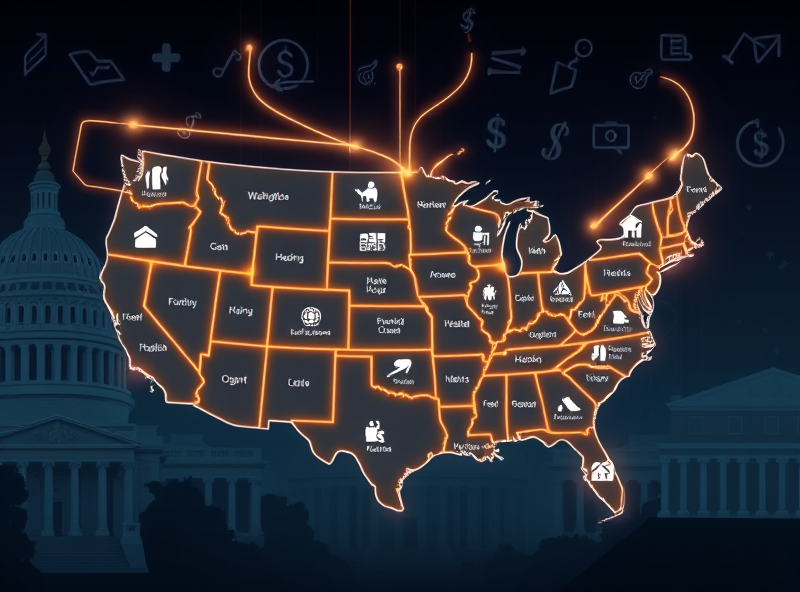
How U.S. Federal Grants Shape Social Welfare Policy

Hello, thoughtful readers! When we talk about social welfare in the United States – the programs and policies designed to support individuals and families in need, provide healthcare, ensure access to food, and offer a safety net – it’s a vast and complex topic. These programs touch the lives of millions of Americans, providing essential assistance for everything from medical care and nutrition to housing and income support. But have you ever wondered how these programs are funded and how decisions about who gets help and what kind of help they receive are made? While states play a significant role in administering many social welfare programs, the U.S. federal government provides a massive amount of funding through various grant programs. These federal grants are not just sources of money; they are powerful tools that significantly shape the social welfare policies implemented at the state and local levels. You might ask, “How does money from Washington D.C. actually influence what happens in my state?” or “Do federal grants mean that social welfare policies are the same across the country?” You’re asking questions that get to the heart of American federalism and the intricate relationship between federal funding and state-level policy choices! The purpose of this article is to provide you with a friendly and comprehensive guide to understanding how U.S. federal grants shape social welfare policy, exploring the mechanisms of influence, looking at key program examples, and discussing the implications of this federal-state partnership. Let’s uncover how federal funding plays a crucial role in determining the landscape of social support across the nation.
The Landscape of U.S. Social Welfare and Federalism
Social welfare in the U.S. is a shared responsibility between the federal government and state governments. This is a core principle of American federalism, where power is divided and shared. The federal government sets broad goals, provides funding, and establishes certain requirements, while states have the authority and flexibility to design and administer many programs to meet the specific needs of their populations. This creates a diverse patchwork of social welfare policies across the country, where eligibility rules, benefit levels, and program structures can vary significantly from one state to another, even for programs that receive substantial federal funding. Federal grants are the primary mechanism through which the federal government transfers funds to state and local governments to help finance these social welfare programs. These grants represent a significant portion of state budgets dedicated to social services, making federal funding a critical lifeline for many state-run programs.
How Federal Grants Exert Influence: The “Strings Attached”
Federal grants are rarely just a simple transfer of money. They are typically accompanied by conditions, requirements, and guidelines that states must adhere to in order to receive and continue receiving the funding. These conditions are often referred to as “strings attached,” and they are the primary way the federal government shapes state and local social welfare policy. Here’s how this influence works:
- Setting Policy Priorities: Federal grants are often created to address specific national policy goals or priorities. By offering funding for particular types of programs (e.g., expanding health insurance coverage for low-income children, supporting job training for welfare recipients, funding services for victims of domestic violence), the federal government incentivizes states to develop or expand programs in those areas. States are more likely to invest in areas where federal funding is available to offset costs.
- Establishing Minimum Standards: Federal grants often require states to meet certain minimum standards for eligibility, service delivery, or program administration. For example, federal Medicaid rules set baseline requirements for who must be covered and what essential health benefits must be provided. While states can often choose to offer more generous benefits or cover additional populations, they cannot fall below the federal minimums if they accept the federal funding.
- Mandating Specific Program Features: Federal grants can mandate that state programs include specific features or components. For instance, the Temporary Assistance for Needy Families (TANF) block grant requires states to meet certain work participation rates for welfare recipients. States must design their programs to include components that help recipients meet these work requirements.
- Requiring Data Collection and Reporting: States that receive federal grants are typically required to collect and report data on program participants, services provided, and outcomes achieved. This federal oversight ensures accountability and allows the federal government to track how funds are being used and whether program goals are being met. The data collected can also inform future policy decisions at both the federal and state levels.
- Encouraging Policy Innovation (Sometimes): While often imposing requirements, some federal grants are designed to encourage states to experiment with innovative approaches to social welfare challenges. These might be competitive grants awarded for pilot programs or waivers granted to states to test alternative program models. Successful innovations at the state level can sometimes influence federal policy or be adopted by other states.
- Fiscal Incentives and Penalties: The structure of federal funding itself can influence state policy. For many social welfare programs (like Medicaid), the federal government matches state spending at a certain percentage (the Federal Medical Assistance Percentage – FMAP). This matching structure incentivizes states to spend more on these programs because a significant portion of the cost is covered by federal funds. Conversely, states can face financial penalties if they fail to comply with federal requirements.
These “strings attached” mean that while states have flexibility in implementing social welfare programs, their policy choices are significantly guided and constrained by the conditions tied to the federal money they receive. The federal government uses its funding power to promote national objectives and ensure a degree of consistency and accountability across state-administered programs.
Key Social Welfare Programs Shaped by Federal Grants
Numerous major social welfare programs in the U.S. are structured as federal-state partnerships heavily influenced by federal grants. Let’s look at a few prominent examples:
- Medicaid: This is perhaps the prime example of how federal grants shape state policy. Medicaid is the largest source of health coverage for low-income Americans. It is jointly funded by the federal and state governments. The federal government provides a significant portion of the funding (varying by state based on a formula) and sets mandatory requirements regarding who must be covered (e.g., certain low-income families, pregnant women, individuals with disabilities) and what essential benefits must be provided. However, states have considerable flexibility in setting income eligibility limits (above the federal minimums), determining the scope of optional benefits offered, setting provider payment rates, and administering the program. The Affordable Care Act (ACA) offered states enhanced federal funding to expand Medicaid eligibility to cover more low-income adults. States had the *choice* whether or not to accept this enhanced federal funding and expand their programs, illustrating how federal grants can incentivize, but not always mandate, state policy changes.
- Supplemental Nutrition Assistance Program (SNAP): Formerly known as food stamps, SNAP is the nation’s largest anti-hunger program. It is primarily a federally funded program, with the federal government paying for 100% of the food benefits provided to eligible households and sharing administrative costs with states. The federal government sets the core eligibility rules (based on income, household size, etc.) and determines the maximum benefit amounts. However, states are responsible for administering the program, including processing applications, determining eligibility, and issuing benefits. States have some limited flexibility, such as in how they count certain types of income or resources, or in implementing certain work requirements, but the core policy is set at the federal level and implemented by states using federal funds.
- Temporary Assistance for Needy Families (TANF): TANF was created in 1996, replacing the Aid to Families with Dependent Children (AFDC) program. TANF is a block grant, meaning the federal government provides states with a fixed amount of funding each year, giving states more flexibility in how they use the funds compared to the previous categorical grant structure. States can use TANF funds for a wide range of purposes aimed at helping needy families achieve self-sufficiency, including cash assistance, work support, and services like child care or transportation. However, even as a block grant, TANF comes with significant federal requirements, such as work participation rate requirements, time limits on receiving federally funded assistance, and restrictions on who can receive aid. States have flexibility in designing their specific programs and benefit levels, but they must operate within these federal parameters to receive the block grant funds.
- Child Welfare Services: The federal government provides significant funding to states through various grant programs to support child welfare services, including programs aimed at preventing child abuse and neglect, supporting children in foster care, and facilitating adoption. Grants like the Title IV-E program (Foster Care, Adoption Assistance, and Guardianship Assistance) and the Child Abuse Prevention and Treatment Act (CAPTA) provide funding but also come with federal requirements and standards that influence how states operate their child welfare systems, collect data, and ensure the safety and well-being of children.
- Education Grants (e.g., Title I): While primarily focused on education, grants like Title I of the Elementary and Secondary Education Act (ESEA) are a form of social welfare policy as they provide financial assistance to local educational agencies (LEAs) and schools with high numbers or high percentages of children from low-income families. The goal is to help ensure that all children meet challenging state academic standards. The federal government provides the funding and sets requirements for how the money must be used (e.g., for supplementary educational services, parent involvement programs), influencing how schools support disadvantaged students.
These examples demonstrate how federal grants, whether structured as matching grants or block grants, come with conditions that guide and shape the policies and services delivered by states in critical areas of social welfare.
Implications of Federal Influence on State Policy
The significant role of federal grants in shaping state social welfare policy has several important implications:
- Promoting National Goals: Federal grants are effective tools for promoting national policy goals and ensuring a baseline level of services or standards across states, even in areas where states have primary administrative responsibility.
- Creating Interdependency: States become highly dependent on federal funding to run their social welfare programs. Changes in federal funding levels or requirements can have a significant impact on state budgets and the services they can provide.
- Variations Across States: While federal grants impose requirements, the degree of state flexibility varies by program. This flexibility means that eligibility rules, benefit levels, and the availability of specific services can still differ significantly from state to state, leading to variations in the social safety net experienced by residents in different parts of the country.
- Policy Debates: The balance of power and responsibility between the federal government and states in social welfare policy is a constant subject of political debate. Discussions often revolve around the appropriate level of federal funding, the extent of federal requirements versus state flexibility, and the effectiveness of different grant structures (e.g., categorical grants vs. block grants).
- Accountability: Federal funding comes with accountability requirements. States must demonstrate that they are using funds appropriately and meeting federal objectives, which can involve extensive reporting and oversight.
Understanding this dynamic is key to understanding how social welfare policy is made and implemented in the United States.
The Ongoing Evolution of Federal-State Partnerships
The relationship between federal grants and state social welfare policy is not static; it evolves over time. Changes in federal legislation, shifts in national priorities, economic conditions, and policy innovations at the state level can all influence how these programs are funded and structured. Debates about federalism, the role of government, and the most effective ways to address social challenges will continue to shape the future of federal grant programs and their impact on state policy. For example, discussions about healthcare reform often involve debates about the federal and state roles in funding and administering programs like Medicaid. Similarly, debates about poverty reduction strategies may involve discussions about reforming block grants like TANF or creating new federal funding streams for specific anti-poverty initiatives. Staying informed about these policy discussions is important for understanding the potential future direction of social welfare in the U.S.
Your Connection to Federal Grants and State Policy
Even if you are not directly involved in administering social welfare programs, understanding how federal grants shape state policy is important because these programs impact communities and individuals across the country. They influence access to healthcare, food assistance, support for families, and much more. Being informed about the structure and funding of these programs allows you to better understand the policy debates surrounding them and potentially engage with policymakers or support organizations working to strengthen the social safety net in your state and nationally. Your understanding contributes to a more informed public discourse about how we support those in need.
Federal Grants: A Cornerstone of U.S. Social Welfare
In conclusion, U.S. federal grants are far more than just financial transfers; they are fundamental tools that significantly shape social welfare policy at the state and local levels. Through funding allocation, mandated requirements, policy incentives, and reporting standards, the federal government influences how programs like Medicaid, SNAP, and TANF are designed and administered by states. This federal-state partnership creates a complex but vital system for providing social support across the nation. While states retain some flexibility, their policy choices are heavily guided by the conditions attached to federal funding. Understanding this dynamic is crucial for anyone seeking to understand the landscape of social welfare in the United States. As these programs continue to evolve, the interplay between federal goals and state implementation, driven by the flow of grant money, will remain a central feature of American social policy. Wishing you insight and understanding as you explore the forces shaping social welfare in the U.S.! 😊







